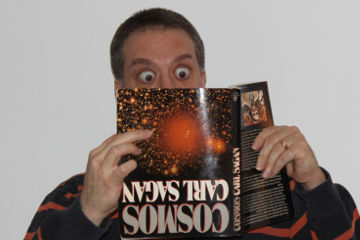What I’ve Learned:
“WIMPs: Massive, dark and WIMPy is no way to go through life, son.”
There are lab geeks, biology nerds and chemistry dorks. But did you know there are also particle physics WIMPs? And that they’re dark and mysterious, and not especially wimpy at all?
(Also, they’re not particle physicists. Most of them couldn’t punch their way out of a wet bag full of hadrons.
I’m just saying. Banging atoms together and scribbling down equations all day doesn’t exactly qualify as “cross-training”.)
WIMPs are actually elemental particles — specifically, Weakly Interacting Massive Particles. Or rather, they would be, if they weren’t hypothetical, which at the moment is what they actually are. Or aren’t. Or might be. Theoretical physics is sort of confusing to talk about.
Let’s try this: if they exist, WIMPs might be the particles that make up the “dark matter” astrophysicists are always going on about. In fact, that’s basically how the idea of WIMPs came about.
Basically, “dark” matter is stuff out there in the universe that — unlike stars, planets, space junk and giant Pharaoh Bender statues — can’t be seen with a telescope. That’s because dark matter doesn’t interact via electromagnetic means, so observations using light, infrared, X-rays, radio waves and basically all the other ways we probe the universe, are off the table. The dark matter — or something — must be there, because it exerts gravitational effects on the things we can see. And there’s a hell of a lot of it — more than four times the amount of “un-dark” matter in the universe.
(This may seem like esoteric cosmological knowledge, but it really comes in handy for making yourself feel better when you’ve cheated on a diet. Just remember: for every cupcake you eat, there’s four more cupcakes’ worth of dark matter out there somewhere that you haven’t eaten. So that’s something.)
According to smart space people — that’s smart people who study space, not smart people from space, obviously — one way of working out what dark matter is made from involves a relatively heavy particle that interacts only via gravity and the weak nuclear force. (Hence the “W” in WIMP, for weak; see what they did there.)
At the same time, one flavor of a popular particle physics theory called “supersymmetry” predicts elemental particles with the very same properties. This confluence of “two great tastes that taste great together”, theoretically speaking, has been dubbed the “WIMP miracle” in scientific circles.
(Thus replacing the previous scientific definition of “wimp miracle”, which was “that time Anthony Michael Hall and the other goober created Kelly LeBrock in their bedroom”.)
Miracles aside, the big problems with WIMPs is that nobody has ever seen one. They wouldn’t be easy to find, naturally, but theories suggest that they might be produced in places like galactic centers, certain particle accelerator collisions and possibly the sun. Mostly, physicists have to search for detectable breakdown products of rare events that suggest WIMPs were involved, and hope they see enough evidence to distinguish from other possible sources. So far, they haven’t.
As the search for WIMPs continues, other theories attempting to explain dark matter have emerged. These include strong interacting massive particles, massive compact halo objects (including black holes) and robust associations of massive baryonic objects. All of which have corresponding acronyms, of course.
So particle physics has ranged from WIMPs to SIMPs to MACHOs to RAMBOs. In other words, it’s run through the Weird Science plot from the miracle girl’s perspective. That’s nice, but it hasn’t solved the mystery of dark matter yet. Somebody call me when the Chet hits the fan.





